Adding Server and Client Support Task Map
Table 4-1 Adding Server and Client Support Task Map|
Task |
Description |
For Instructions, Go To |
|---|---|---|
|
1. Update System Types |
Optional. Make sure Host Manager recognizes all the previously added system types. | |
|
2. Set Defaults for Adding Support |
Optional. Before you add support for several clients, set up defaults for the Add window by choosing Set Defaults from the Host Manager's Edit menu. | |
|
3. Add Support for a Standalone System |
Add support for a standalone system by choosing Add from the Host Manager's Edit menu. You can also convert a AutoClient system or generic system to a standalone system by choosing Convert to Standalone from the Edit menu. | |
|
4. Add Support for an OS Server |
Add Support for an OS Server Add support for an OS server by choosing Add from the Host Manager's Edit menu. | |
|
|
Convert a Standalone System to an OS Server Convert a standalone system to an OS server by choosing Convert from the Host Manager's Edit menu. You can add Solaris 7 OS services during the conversion. | |
|
5. Add OS Services to an OS Server |
Add SunOS 4.0 and Compatible OS Services If you need to add support for SunOS 4.0 and compatible diskless clients, an OS server must have the appropriate SunOS 4.x services added. |
"How to Add SunOS 4.0 and Compatible OS Services to an OS Server" |
|
|
Add Solaris 7 and Compatible OS Services. If you need to add support for Solaris 7 and compatible diskless or AutoClient systems, an OS server must have the appropriate Solaris 7 and compatible services added. | |
|
6. Add Support for Client Systems |
Add Support for an AutoClient System Add support for an AutoClient system by choosing Add from the Host Manager's Edit menu. | |
|
|
Add Support for a Diskless Client Add support for a diskless client by choosing Add from the Host Manager's Edit menu. |
How to Start Solstice Host Manager
-
Verify that the following prerequisites are met. To use Solstice Host Manager, you must have:
-
Solstice AdminSuite installed.
-
A bit-mapped display monitor. The Solstice AdminSuite software can be used only on a system with a console that has a bit-mapped screen such as a standard display monitor that comes with a Sun workstation.
-
If you want to perform administration tasks on a system with an ASCII terminal as the console, use Solaris commands instead.
-
An X Window system installed and running.
-
Superuser (root) privilege or membership in the sysadmin group (group 14) and the required access privileges for managing the NIS or NIS+ database.
Note -If your name service is NIS+, you must be a member of the NIS+ admin group.
-
-
Start the Solstice Launcher.
$ solstice &
The Solstice Launcher Menu is displayed.
-
Click on the Host Manager icon.

The Load window is displayed.
-
Select the name service used in your network.
-
Check that the domain or host name is correct.
If not, type the domain or host name you need to access.
-
Click on OK.
The Solstice Host Manager main window is displayed.
Example--Host Manager Main Window
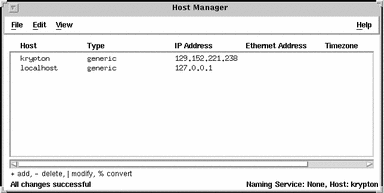
How to Update System Types
This procedure attempts to determine the system types for systems marked as generic.
-
Start Solstice Host Manager from the Solstice Launcher and select the name service, if not done already.
See "How to Start Solstice Host Manager" for more information.
-
Select Update System Types from the File menu on the Solstice Host Manager Window.
-
Click on Update to update the systems marked as generic.
-
Verify the system has been converted to generic in the Solstice Host Manager Window.
How to Set Defaults for Adding Support
-
Start Solstice Host Manager from the Solstice Launcher and select the name service, if not done already.
See "How to Start Solstice Host Manager" for more information.
-
Choose Set Defaults from the Edit menu.
The Set Defaults window is displayed.
-
Fill in the Set Defaults window.
The defaults you select will be the initial defaults values in the Add window. If you need information to complete a field, click on the Help button to see field definitions for this window.
-
Click on OK.
How to Add Support for a Standalone System or OS Server
The high-level steps in this procedure are:
-
Adding information about the system
-
(Optional) Setting up remote install capabilities for the system
-
(Optional) Installing the system
-
Start Solstice Host Manager from the Solstice Launcher and select the name service, if not done already.
See "How to Start Solstice Host Manager" for more information.
-
Select Add from the Edit menu on the Solstice Host Manager Window.
The Add window is displayed.
-
Fill in the system information, selecting Solaris Standalone or OS Server as the system type.
The system information includes all the fields from the host name through the timezone. If you need information to complete a field, click on the Help button to see field definitions for this window.
-
If you want to set up remote install capabilities for the system, continue to Step 5. If not, skip to Step 10.
-
Click on Enable Remote Install.
-
Select an Install Server.
The Install Server defaults to the current host. Select Other from the Install Server menu to specify another host as the install server.
-
Click on Set Path to identify the path to the Solaris CD image on the install server.
If the install server is a remote system, note that it must be minimally set up as a managed system.
If You Are Using ...
And ...
Then Enter the Path ...
The Solaris CD as the Solaris CD image
The Solaris CD is managed by Volume Management
/cdrom/cdrom0 or /cdrom/cdrom0/s0 or /cdrom/cdrom0/s2
The Solaris CD is not managed by Volume Management
Where you mounted the Solaris CD
A copy of the Solaris CD on the install server's hard disk (by using setup_install_server)
To the Solaris CD image
-
Select the system's architecture type and OS release from the OS Release menu.
The architecture type must match the system's architecture and the OS release should match the Solaris release you want to remotely install on the system.
-
If necessary, specify a boot server or profile server.
To specify another server other than the default, select Other from the menu. Select a Profile Server from the Profile Server pull-down menu. You must also specify a path to the boot software on the boot server or the custom JumpStart directory on the profile server.
To set up the other components of a custom JumpStart installation and preconfiguring network and system information, see Solaris Advanced Installation Guide.
-
Click on OK on the Add window.
-
Select Save Changes from the File menu to add support for the standalone system or OS server.
The standalone system or OS server is displayed in the Host Manager main window.
-
Verify the OS server information is correct in the Host Manager main window.
-
(Optional) Boot and install the standalone system or OS server.
For more information about booting and installing, see Solaris Advanced Installation Guide.
Note -If you are installing an OS server, you must allocate space in /export and /export/swap for the desired number of clients.
Example--Completed Host Manager Add Window for a Standalone System
The following example shows a completed Add window for the standalone system venus.
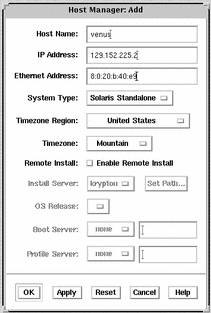
Where to Go From Here
If you want to add OS services after you install an OS server, see "How to Add Solaris 7 OS Services to an OS Server".
How to Convert a System to an OS Server
-
Start Solstice Host Manager from the Solstice Launcher and select the name service, if not done already.
See "How to Start Solstice Host Manager" for more information.
-
Select a host entry from Solstice Host Manager's main window.
You can convert a standalone system and generic system to an OS server.
-
Select Convert to OS Server from the Edit Menu.
The Convert window is displayed, and the selected system is displayed in the host name field.
-
Click on the Add button in the OS Services window to add services.
-
Click on Set Path to identify the path to the Solaris CD image from which to add the client services.
The Install Server defaults to the current host. Select Other from the Install Server menu to specify another host as the install server. Note that a remote system must be minimally set up as a managed system.
If You Are Using ...
And ...
Then Enter the Path ...
The Solaris CD as the Solaris CD image
The Solaris CD is managed by Volume Management
/cdrom/cdrom0/s0 or /cdrom/cdrom0/s2 on SPARC platforms, /cdrom/cdrom0 on x86 platforms
The Solaris CD is not managed by Volume Management
Where you mounted the Solaris CD
A copy of the Solaris CD on the Install Server's hard disk (by using setup_install_server)
Where you specified setup_install_server to copy the Solaris CD
-
Specify the type of services you want to add and click on Add.
The OS service is added to the OS Services list and marked with a plus sign (+), which means it will be added when you save changes. You can use the Delete button to delete an OS service from the list before you save changes.
-
Click on OK on the Convert window.
-
Select Save Changes from the File menu to convert the system to an OS Server.
The converted system is displayed as an OS server in the Host Manager main window.
-
Verify the host type has been updated in the Host Manager main window.
Example--Completed Host Manager Convert Window
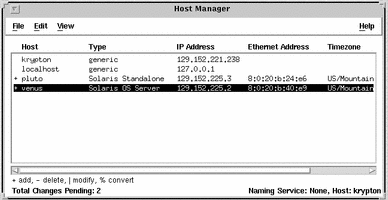
How to Add SunOS 4.0 and Compatible OS Services to an OS Server
Note -
You cannot add SunOS 4.0 and compatible services to x86 OS servers.
The high-level steps in this procedure are:
-
Determining the OS server to which you want to add SunOS 4.0 and compatible OS services for diskless clients
-
Installing the required SunOS 4.0 and compatible release software (install4x command)
-
Log in as superuser on the OS server to which you want to add SunOS 4.0 and compatible OS services for diskless clients.
-
Insert the Solstice AdminSuite 2.3 CD into your CD-ROM drive.
This step assumes that your system is running Volume Management.
-
Change directory to the location of the software.
# cd /cdrom/Solstice_sysmgt_2.3/4.x
-
Install the SunOS 4.0 and compatible heterogeneous install software.
# pkgadd -d `pwd` SUNWhinst
-
Eject the Solstice AdminSuite 2.3 CD.
# cd # eject cd
-
Insert the SunOS 4.0 or similar release CD into your CD-ROM drive.
This step assumes that your system is running Volume Management, and the CD-ROM drive is directly attached to the server. Volume Management automatically mounts the CD directory on /cdrom/volume1/s0.
-
Start the SunOS 4.0/4.1 release software installation program.
# /usr/sbin/install4x -m /cdrom/volume1/s0 -e /export
The main menu is displayed.
*** 4.1* Install Main Menu *** Choose an Architecture (then select modules to load): Modules Loaded Selected [a] sun4.sun4c.sunos.4.1.2 0 0 [b] sun4.sun4.sunos.4.1.2 0 0 [c] sun4.sun4m.sunos.4.1.2 0 0 or begin the loading process for all selected modules: [L] Load selected modules or abort without loading any modules: [Q] Quit without loading +-------------------+ | Disk Usage: | | 0K Selected | | 53634K Free | +-------------------+ Type any bracketed letter to select that function. Type ? for help. -
On the main menu, specify the architecture you want to support by typing the associated character that is shown in brackets.
The Module Selection menu is displayed.
Select sun4.sun4c.sunos.4.1.2 modules: +[a] R proto root............240K | [o] User_Diag..............6352K +[b] R usr.................26240K | [p] Manual.................7456K +[c] R Kvm..................4832K |+[q] D TLI..................... 48K +[d] R Install...............936K | [r] D RFS.................... 912K [e] D Networking...........1040K | [s] D Debugging..............2928K [f] D System_V.............4008K | [t] SunView_Programmers....1840K [g] D Sys..................5288K | [u] Shlib_Custom...........1376K [h] C SunView_Users........2664K | [v] Graphics...............1784K [i] SunView_Demo..........512K |+[w] uucp....................608K+ [j] Text..................712K |+[x] Games.............. ...3136K [k] Demo.................4264K | [y] Versatec...............5960K [l] C OpenWindows_Users...25936K | [z] Security................312K [m] C OpenWindows_Demo.....4288K | [A] OpenWindows_Programmers.10200K [n] C OpenWindows_Fonts ...7840K | Module + = already loaded R = Required C= Common Legend: ** = selected for loading D = Desirable Others are optional Select [a-A] or a Quick-Pick Option: +-------------------+ [1] All Required Modules [4] All Optional Modules | Disk Usage: | [2] All Desirable Modules[5] All Modules | 0K Selected | [3] All Common Modules | 53634K Free | or [D] (done) to return to the main screen +-------------------+ -
Select modules to load by typing the associated character that is shown in brackets.
The Module Selection screen readily enables you to pick groups of modules to be loaded. When you enter a 1, it marks all required modules for loading. When you enter a 2, it marks all recommended modules. When you enter a 3, it marks all commonly loaded modules. When you enter a 4, it marks all optional modules. When you enter a 5, it marks all modules shown on the Module Selection screen.
-
Return to the main menu by typing D.
The main menu is displayed.
*** 4.1* Install Main Menu *** Choose an Architecture (then select modules to load): Modules Loaded Selected [a] sun4.sun4c.sunos.4.1.2 0 4 [b] sun4.sun4.sunos.4.1.2 0 3 [c] sun4.sun4m.sunos.4.1.2 0 1 or begin the loading process for all selected modules: [L] Load selected modules or abort without loading any modules: [Q] Quit without loading +-------------------+ | Disk Usage: | | 0K Selected | | 53634K Free | +-------------------+ Type any bracketed letter to select that function. Type ? for help. -
Type L to install the software.
The modules you previously selected are installed.
Installing module `proto root' [size: 248K] in directory /export/exec/proto.root.sunos.4.1.2 ... Updating server databases ... Press any key to continue: -
After the modules are installed, press any key to return to the main menu.
The loaded modules are displayed in the main menu.
-
If you want to add support for other architectures, repeat Step 8 through Step 11. Otherwise, type Q to exit.
Note -There is no command-line equivalent for adding SunOS 4.0 or compatible services to an OS server.
-
Verify the SunOS 4.0 or compatible services have been added by listing the contents of the /export/SunOS_4.x directory.
Where to Go From Here
If you want to add SunOS 4.0 or similar support for a diskless client, see "How to Add Support for a Diskless Client".
How to Add Solaris 7 OS Services to an OS Server
Note -
The name of this release is Solaris 7 but code and path or package path names may use Solaris 2.7 or SunOS 5.7. Always follow the code or path as it is written.
-
Start Solstice Host Manager from the Solstice Launcher and select the name service, if not done already.
See "How to Start Solstice Host Manager" for more information.
-
Select an OS server to modify from the Host Manager main window.
-
Select Modify from the Edit menu on the Solstice Host Manager Window.
The Modify window is displayed.
-
Click on the Add button in the OS Services window to add services.
-
Click on Set Path to identify the path to the Solaris CD image from which to add the client services.
The Install Server defaults to the current host. Select Other from the Install Server menu to specify another host as the install server. Note that a remote system must be minimally set up as a managed system.
If You Are Using ...
And ...
Then Enter the Path ...
The Solaris CD as the Solaris CD image
The Solaris CD is managed by Volume Management
/cdrom/cdrom0/s0 or /cdrom/cdrom0/s2 on SPARC platforms, /cdrom/cdrom0 on x86 platforms
The Solaris CD is not managed by Volume Management
Where you mounted the Solaris CD
A copy of the Solaris CD on the Install Server's hard disk (by using setup_install_server)
Where you specified setup_install_server to copy the Solaris CD
-
Specify the type of services you want to add and click on Add.
The OS service is added to the OS Services list and marked with a plus sign (+), which means it will be added when you save changes. You can use the Delete button to delete an OS service from the list before you save changes.
-
Click on OK on the Add window.
-
Select Save Changes from the File menu to add services.
-
Verify that the OS services directories are available by listing the contents of the /export/Solaris_2.7 directory.
Example--Completed Add OS Services Window
The following example adds the Solaris 2.7 SPARC sun4m service to the OS server venus.
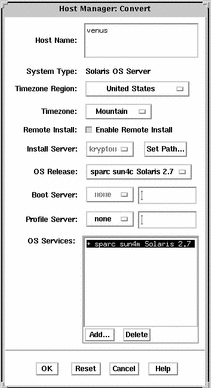
How to Add Support for an AutoClient System
Note -
This procedure assumes that the AutoClient server is already set up as an OS server and is already installed with the kernel architectures of the AutoClient system(s) to be added. For information on adding an OS Server or converting an existing system to an OS Server, see the online help or the Solstice AdminSuite 2.3 Administration Guide.
-
Start Host Manager from the Solstice Launcher and select the name service, if not done already.
See "How to Start Solstice Host Manager" for more information.
-
Choose Add from the Edit menu. The Add window is displayed. Note that the default system type is Solaris Standalone.
-
Choose Solstice AutoClient from the System Type menu.
The Add window for a Solstice AutoClient system is displayed.
-
Fill in the system information for the AutoClient system.
-
Click on OK after entering the required information.
If you have not enabled licensing for the Solstice AutoClient feature, you will see a message saying that the software was unable to check out a license. For information on enabling licensing, see Solstice AutoClient 2.1 Installation and Product Notes.
The AutoClient system becomes part of the list of AutoClient systems to add, and it is displayed on the Host Manager main window with a plus sign (+) next to it. The + means that the system is a "pending add."
-
Repeat Step 2 through Step 5 to add subsequent AutoClient systems to your "batch" of pending changes.
The "Total Changes Pending" status will be incremented each time you add a system.
-
Choose Save Changes from the File menu when you are ready to confirm addition of all the AutoClient systems listed in the window.
The Saving Changes message window appears. All of the AutoClient systems are added when you choose Save Changes from the File menu.
Adding each client takes several minutes, depending on server speed, current load, and the number and type of patches that will be automatically added.
As each AutoClient system is successfully added (as shown in the Saving Changes window), its corresponding entry no longer appears as a pending add in the Host Manager main window (that is, the + no longer appears next to the host name).
 Caution -
Caution - For the AutoClient system to work properly, it needs superuser access to its /export/root directory. If Host Manager displays a message that the /export directory is already shared and has different share options than required, you need to allow superuser access to the client root area before the AutoClient system will function properly. The access mode for the client root is normally rw=clientname, root=clientname.
If Host Manager displays a message that the /usr directory is already shared, it is because it tried to share /usr read-only. If you have it shared with read-write permissions, then /usr is set up correctly, and you do not have to make any modifications.
-
Boot your AutoClient system(s) from the network.
For more information about booting your AutoClient systems, see Solstice AutoClient 2.1 Administration Guide.
-
Provide system configuration information for the AutoClient system during the initial boot process, if prompted.
-
Create a superuser password when prompted.
Example--Completed Host Manager Add Window for an AutoClient System
The following example shows a completed Add window for the Solstice AutoClient system mars.

How to Add Support for a Diskless Client
The high-level steps in this procedure are:
-
Adding system information about the diskless client
-
Selecting OS services for the diskless client
-
Booting the diskless client
Note -This procedure assumes the system providing the services (the file server) has already been configured as an OS server.
-
Start Solstice Host Manager from the Solstice Launcher and select the name service, if not done already.
See "How to Start Solstice Host Manager" for more information.
-
Select Add from the Edit menu on the Solstice Host Manager main window.
The Add window is displayed.
-
Fill in the system information, selecting Solaris Diskless as the system type.
The system information includes all the fields from the host name through the time zone. If you need information to complete a field, click on the Help button to see field definitions for this window.
-
Select a File Server.
The File Server defaults to the current host. Select Other from the Install Server menu to specify another host as the install server.
-
Select the client's architecture type and the OS release from the OS Release menu.
The architecture type must match the diskless client's architecture, and the OS release should match the Solaris release you want the diskless client to run.
-
Identify the system's root path, swap path, and swap size.
-
Click on OK on the Add window.
-
Select Save Changes from the File menu to add support for the diskless client.
The diskless client is displayed in the Host Manager main window. It takes several minutes to add the diskless client support, particularly to create the system's root and swap areas and apply any applicable patches with the admclientpatch command.
 Caution -
Caution - For the diskless client to work properly, it needs superuser access to its /export/root directory. If Host Manager displays a message that the /export directory is already shared and has different share options than required, you need to allow superuser access to the client root area before the diskless client will function properly. The access mode for the client root is normally rw=clientname, root=clientname.
If Host Manager displays a message that the /usr directory is already shared, it is because it tried to share /usr read-only. If you have it shared with read-write permissions, then /usr is set up correctly, and you do not have to make any modifications.
-
Verify that the system has been added as a diskless client in the Host Manager Main Window.
-
Boot the diskless client.
-
Provide the following system configuration information for the diskless client during the initial boot process, if prompted.
-
Geographic region
-
Time zone
-
Date and time
-
-
Create a superuser password when prompted.
Example--Completed Host Manager Add Window for a Diskless Client
The following example shows a completed Add window for the diskless client neptune.
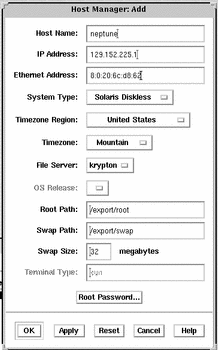
- © 2010, Oracle Corporation and/or its affiliates
